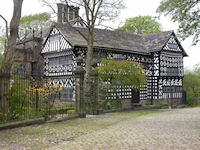
Figure 47: Hall i' th' Wood
Hall i' th' Wood, Bolton, Lancashire (SD 72432 11610), was built in the early 16th century, and a new stone frontage was added in the late 1500s to mid 1600s (Fig. 47). It is Grade I listed.
The house was built by a wealthy yeoman and merchant family, the Brownlow family. The display of the house now focuses more on one of its later residents, Samuel Crompton, who invented the Spinning Mule - a machine important in the industrialisation of cotton spinning. Crompton lived in part of the building when it was subdivided into rented dwellings in the 18th century.
Hall I' th' Wood was presented to the people of Bolton by Lord Leverhulme: William Hesketh Lever in 1899, and opened to the public in 1902, run by the town local corporation.
When Hall i' th' Wood was acquired by Lord Hesketh Lever, work was undertaken to replace timbers in the building, especially in the roof structure, as well as repointing some of the stonework and re-daubing some exterior panels. This work doesn't seem to have affected the layout of the building or removed later material. The original interpretation included a significant amount of information about the building and its construction (Midgley 1927, 13).
From c. 1927 the house was promoted as a museum, and the structure itself became just one part of the interpretation. Information was also presented about the life of the Hall's most famous inhabitant, Samuel Crompton, as well as folk life in the area (Mills 1995, 25-8; Midgley 1927, 13).
A scheme for the redisplay of Hall i' th' Wood was presented to Lord Leverhulme for approval in 1915, in view of his donation of the house to the corporation of Bolton. The curator at the time recorded that 'the interest which his Lordship took in the acquisition of these antique furnishings and obsolete household appliances is shared by his fellow townspeople, to whom they were presented' (Midgley 1927, 13). It was considered that the building itself was of 'considerable interest'; 'better than any existing building in this neighbourhood it illustrates the architecture during the XV, XVI and XVII centuries of the type of dwelling occupied by those well-to-do yeoman farmers' (Midgley 1927, 3).
A report on the condition of the fabric in 1992 revealed that some of the timber inserted into the roof structure in the 19th century was decaying, and after a full inspection it was revealed that all the pine used in that phase of reconstruction timber would need to be replaced with oak (Mills 1995, 25-8). Other Victorian work at Hall i' th' Wood used non-traditional materials for panel infills, which had held water against the timbers so that they subsequently decayed. This necessitated replacement of those elements in the mid-1990s (Fig. 49) (Mills 1995, 23).
The donation of Hall i' th' Wood to the people of Bolton was part of a wider move by wealthy Victorians to acquire and restore historic buildings, and present them to the local community for education and enjoyment. The reconstruction of buildings fulfilled an interest in historic places, and the philanthropic giving of them to 'the people' followed the contemporary focus on social improvement through education (Ward 1883). Despite the existence of a conservation movement with clearly defined principles in the practice of 'restoration', the nature of the changes made to buildings rarely conformed to the conservation philosophy of organisations like the Society for the Protection of Ancient Buildings. As this house demonstrates, some phases of reconstruction actually necessitate later ones, and thus as knowledge about a building develops, styles change or practical reasons engender alterations. Figure 48 shows the layers of change undertaken on the building, the final phase of which was repairs of the first phase works.
Hall i' th' Wood's presentation as a folk museum was, again, typical of an age when interest in the history of the folk life of England was growing, at a time when the ongoing practice of folk traditions was seen to be disappearing, and warranted attention and study (Boyes 1993, 21; Bennett 1995, 109-10). This parallels the development of folk museums and open-air museums at Cregneash, Isle of Man, St Fagans, Cardiff, and the Ulster Folk Museum, Northern Ireland (Stratton 1996, 156-164; Johnson and Thomas 1993, 173-4).
The preservation and display of historic buildings in this period was often a case of local pressure plus the interest and funding of a few key individuals. This was the case at Selly Manor and Minworth Greave, Bourneville; Bramall Hall, Cheshire, and Bishop's House in Sheffield.
Buildings like Hall i' th' Wood are well suited to use as a museum because of their direct link with a particular aspect of local history: the spinning mule transformed the cottage industry of cloth-making into a far more profitable process, and laid the foundations for the later development of the textile industries in the north west. The home of its inventor provides a location for interpretation of this aspect of locally and nationally important history.
© Internet Archaeology/Author(s)
University of York legal statements | Terms and Conditions
| File last updated: Mon Jan 24 2011